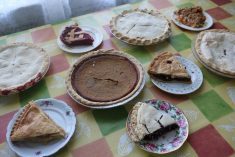Roll out the grill, it’s time for a mealtime rest. So decorate your table with fresh blooming flowers and enjoy simple appetizers, which when served as a bunch can make up a meal. The following recipes are my summertime favourites, some from my childhood and others are new.
Tangy fruit dip
Combine and beat until smooth:
1 package (four-serving)
vanilla instant pudding
1/2 cup milk 125 mL
Fold in with wire whisk:
2 cups stiff whipped 500 mL
cream or topping
Read Also

Farmland ownership fires up Saskatchewan politicians
Saskatchewan politicians debate the enforcement of farmland ownership laws in the province.
2 tablespoons 25 mL
Amaretto or orange juice
Refrigerate and serve with fresh fruit pieces.
Shrimp dip
2 cups sour cream 500 mL
1/4 cup chili sauce or 60 mL
ketsup
1 can (4 oz.) broken 113 g
or small shrimp, drained
and mashed
1/2 teaspoon lemon 2 mL
juice
1/2 teaspoon 2 mL
Worcestershire sauce
1 teaspoon minced 5 mL
onion
1/2 teaspoon beef 2 mL
bouillon powder
Combine all seven ingredients in a bowl. I do mine in a food processor. Serve chilled with raw vegetables.
Beef and vegetable kabobs
1 pound boneless beef 500 g
sirloin steak, cut into one
inch/2.5 cm cubes
1/2 cup Greek 125 mL
dressing, divided
12 cherry tomatoes
6 medium button mushrooms,
cut in half
8 asparagus spears, blanched,
cut into two-inch/5 cm
lengths
Place steak in large resealable plastic bag. Add 1/4 cup (60 mL) of the dressing; seal bag. Refrigerate 30 minutes to marinate. Remove steak from marinade and discard bag and marinade.
Preheat barbecue to medium heat. Thread steak onto 12 wooden skewers alternately with the tomatoes, mushrooms and asparagus.
Grill kabobs 15 minutes or until steak is cooked through and
vegetables are crisp and tender, turning and brushing occasionally with the remaining 1/4 cup (60 mL) dressing.
Source: Kraft Kitchens, www.kraft.ca.
Fresh strawberry pie
6 cups plus 1 cup 1.5 L plus 250 mL
fresh strawberries
1 (9 inch/22 cm) pastry shell
baked
2/3 cup sugar 150 mL
1/2 cup water 125 mL
2 tablespoons 25 mL
cornstarch
2 tablespoons cold 25 mL
water
whipped topping
Set aside one cup (250 mL) strawberries. Arrange remaining berries in a pie shell. With a fork, mash reserved cup (250 mL) strawberries; set aside.
In a saucepan, combine sugar and water; cook and stir until sugar is dissolved. Add mashed strawberries and bring to a boil.
Combine cornstarch and cold water until smooth. Gradually stir into strawberry mixture. Bring to a boil, then cook and stir for two minutes or until thickened.
Cool for 15 to 20 minutes, stirring occasionally. Spoon over strawberries in crust. Refrigerate for at least two hours.
Garnish with whipped topping. Yield: Eight servings.
Source: Taste of Home, Light & Tasty Annual Recipes 2008.
Rhubarb torte
If strawberries are not your thing, try this rhubarb dessert. I printed this recipe about six years ago. I tried it for the first time at a Czech Hall community shower, and everyone insisted that this recipe, made by Joyce Massie, must appear in The Western Producer. Since that time I have had requests to reprint it as some had misplaced the recipe.
Crust mix:
2 cups graham wafer 500 mL
crumbs
1/2 cup packed brown 125 mL
sugar
1/2 cup melted butter 125 mL
1 teaspoon cinnamon 5 mL
Note: Save 1/2 cup (125 mL) of the above mixture for the topping.
Press into a 9 x 13 inch (22 x 33 cm) pan.
Second layer:
In a saucepan add:
4 cups sliced rhubarb 1 L
11/2 cup water 125 mL
3 tablespoons 45 mL
cornstarch
1 cup sugar 250 mL
Cook in the saucepan until thickened and clear. Pour over wafer base. Chill.
Third layer:
In a mixing bowl prepare:
4 oz. vanilla instant 113g
pudding
2 cups cold milk 500 mL
Beat with a wire whisk or electric mixer at the lowest speed for approximately two minutes. Pour over rhubarb layer. Chill.
Topping:
1 cup whipping cream 250 mL
(or one envelope of topping)
2 cups mini 500 mL
marshmallows
Prepare the whipped topping. Fold in the marshmallows. Spread on the prepared layers and top with remaining crumbs. Chill and serve.
Note: I prepared it without the marshmallows and added a bit more whipped cream. It was also delicious this way.
Book about eating
Summer is not just about eating. It is also a time for picking up a book. What do I recommend? An Apple a Day by Dr. Joe Schwarcz, is a must-read book for anyone interested in what we eat. The book enlightens readers on contradicting views.
Eat salmon. It’s full of good omega 3 fats. Don’t eat salmon. It’s full of PCBs and mercury. Eat more veggies. They’re full of good antioxidants. Don’t eat more veggies. The pesticides will give you cancer.
You have to be a nutritional scientist these days before you sit down to eat, which is why we need Schwarcz. His book explains the science of what is happening in our bodies every time we ingest a morsel of food, and he explores the misconceptions in our obsession with diets, nutrition and weight.
For more information, visit www.joeschwarcz.ca.
The sunscreen lifestyle
It’s important to spend time outdoors, but by incorporating some common sense protective measures, we can play outside while still minimizing our exposure to UV radiation.
- Make sure the SPF in your sunscreen is 15 or higher. Buy new sunscreen every year.
Here are some that I recommend:
Kinesys Kids Sunscreen Spray with Parsol 1789, SPF 30+ (I use this one. It is easy to apply and available at drugstores and Costco).
Lavera Sun Screen Neutral SPF 40/ Sun Spray SPF 15.
Sun Milk SPF 10/15/20/25 (all use titanium dioxide and zinc oxide. Some are fragrance free).
Aubrey Organics – Sun Shade SPF 12/15.
Titania Full Spectrum Sunblock SPF 25.
- Avoid sun during midday and when it is at its peak. Sun is more intense at high altitudes and in the tropics, and UV radiation reflects
off sand, water, snow and concrete so take special care in these situations.
- Seek shade whenever you can, but remember that invisible rays can reflect up toward you from the ground, so you may still need protection.
- Reapply sunscreen often because it washes off in water and breaks down in sunlight.
- You know your skin best, so examine it regularly for changes, lesions and spots. Be extra careful if you have freckles, moles, take certain medications such as some antibiotics, or have a family history of skin cancer.
How to avoid dehydration
It’s hard to drink enough water. Our bodies are like big pails of water with a little bit of sodium, a dash of calcium, mixed with potassium and a sprinkling of other elements. Getting enough water is necessary for healthy body functions, including to:
- Lubricate joints so they move smoothly.
- Provide a cushion for organs and tissues. For example, the brain needs enough fluid
to stay afloat and remain protected from bumps.
- Transport nutrients and waste products. The blood needs to have enough fluid to transport nutrients. Likewise, the intestinal tract needs enough fluid to move wastes through the body.
- Regulate body temperature.
Drinking too little water can cause mild dehydration, although most people don’t realize it. The symptoms of mild dehydration include headache, fatigue and drops in mental and physical strength.
To test, pinch the back of your hand. If the fold of the skin does not snap back into place when released, you may be dehydrated.
Losing as little as three percent of your body’s weight can cause symptoms. For someone who weighs 150 pounds, that’s just about 41/2 lb. Losing 15 to 20 percent of your body weight as fluid can be fatal, which can happen during very hot weather or to outside workers or athletes.
We lose about eight to 12 cups of water daily through respiration, perspiration, digestion and urine. Since the body does not store a lot of water, it must be replaced through food and fluids.
Most fruits and vegetables are 80 to 90 percent water. Following a balanced eating plan and drinking enough fluids hydrate the human body adequately.
Thirst is not always an accurate indicator of whether you are dehydrated. In fact, the body’s thirst mechanism does not kick in until you have lost that three percent of body weight that indicates early dehydration. Try these tips to stay hydrated.
- Develop a routine – drink water when you wake up, at each meal, between meals and before bed.
- Eat plenty of fruits and vegetables.
- If you don’t like the taste of plain water, add lemon or lime.
- Sports drinks and juices are good alternatives, but high in calories. Try diluting the drinks with an equal amount of water.
- Caffeine in beverages like coffee, tea and soft drinks deplete the body of fluids. Alcoholic beverages are also dehydrating and promote fluid loss. If you drink alcohol or
caffeine, replace each beverage consumed with the same amount of water.
- Invest in a sturdy, insulated water bottle and keep it with you during the day.
- A darker coloured urine means you likely need to drink more.
Jodie Mirosovsky is a home economist from Rosetown, Sask., and one of four columnists comprising Team Resources. Send correspondence in care of this newspaper, Box 2500, Saskatoon, Sask., S7K 2C4 or contact them at team@producer.com.














